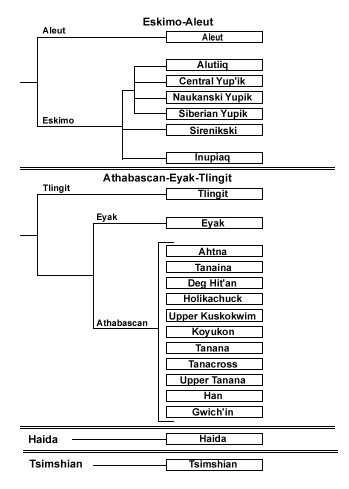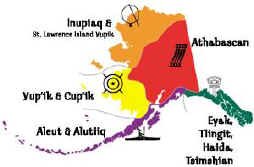|
Alaska's Native Cultures |
|
|
Alaska Native Heritage Center |
Anthropologists believe that the original Native peoples crossed from Siberia to North America over the Bering land bridge that connected the two continents. However, we need to be aware that the Alaska Natives have their own belief system about their origins. They have their own creation stories that are taught from generation to generation about who they are.
The Inupiaq and Yupik are scattered throughout the northern and western regions of Alaska, while the Aleuts are settled mainly on the islands later named for them, the Aleutians.
The Inupiaqs and Yupiks lived north and west of the Athabascans. In this harsh land they hunted, fished, and gathered the berries and roots that grew during the brief, cool summers. Inupiaqs and Yupiks hunters harpooned whales from small, skin covered canoes called umiaks. The Inupiaqs and Yupiks also hunted for walrus, seals, and polar bears. They followed the herds of caribou that migrated across the frozen tundra. For more information view YUP'IK AND CUP'IK and the INUPIAQ AND SAINT LAWRENCE ISLAND YUPIK
The smallest group of Alaska Natives, the Aleuts, were hardy people who lived off the sea. Their food, clothing, shelter, heat, and tools came from creatures living in the ocean or along its shoreline. Exceptional sailors, the Aleuts sometimes paddled hundreds of miles in skin-covered canoes, called baidarkas, to trade, visit, or stage daring raids on enemy villages. The name Aleut itself is not of Aleut origin. It was introduced by Russian explorers and fur traders who conquered the Aleutian Islands and coastal areas to the east beginning in 1745. The people's historic and traditional name for themselves is Unangan, probably derived from una, which refers to the seaside. For more information view ALEUT & ALUTIIQ
In Southeast Alaska, a region of lush forests, mild climate, abundant fish, game, and edible plants, the Tlingit (pronounced Klinkit), Haida, and Tshimshian Indians make their home. Their culture produced totem poles, ceremonial costumes, and exquisite blankets. The Tlingits were also known to be fierce warriors. When the first Russians tried to settle in Sitka, the Tlingits drove them out, despite the guns and cannons brought by the intruders. For more information view EYAK, TLINGIT, HAIDA & TSIMSHIAN.
The Tlingits of Teslin, Yukon include people of five clans, Wolf, Frog, Beaver, Crow and Eagle. In Tlingit, the clan names are:
Wolf Yanyèdí
Frog Ishkitàn
Beaver Dèshitan
Crow Kukhhittan
Eagle Dakhl'awédí
The Athabascan Indians of central Alaska faced harsher living conditions. Life was often feast or famine. Close relatives of the Navajos and Apaches, the Athabascans were accomplished hunters. They followed herds of caribou and moose for vast distances, and fished for salmon and other river fish. They traded furs and other goods with nearby Tlingits, Inupiaqs and Yupiks. For more information view ATHABASCANS
Today, Alaska's diverse Native peoples remain strong in Alaska.
Alaska Native Language Family Tree |

Alaska Native Language Center
University of Alaska Fairbanks
Yukon Native Language Centre
The Origin of Light an Inuit Lore
The Old Woman an Eskimo Lore
Native American Lore
Alaskan Native Languages detailed info on languages listed in the Family Tree above
Iñupiat of Arctic Alaska
Yup'ik Eskimos
The Tlingit by the Carnegie Museum
What is a Totem Pole
Totem Bight State Historical Park
The Totem Forest
Alaska Native Heritage Center
Totem Poles Theme Page
|
Home Alaska & the Yukon Far North Journal |
